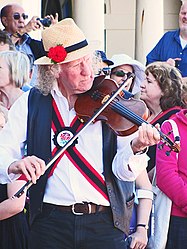
Back Fiðele ANG Fiddle German Violín tradicional Spanish فیدل Persian Fiddle French Fidil Irish Fiddle Galician Ֆիդլ Armenian Fiddle Italian フィドル Japanese
 A morris dance fiddler playing a fiddle. | |
| String instrument | |
|---|---|
| Other names | Violin |
| Classification | Bowed string instrument |
| Hornbostel–Sachs classification | 321.322-71 |
| Developed | Early 16th century |
| Playing range | |
 | |
| Related instruments | |
| |
| Musicians | |
| Builders | |
 |
| Part of a series on |
| Violin |
|---|
| Violinists |
| Fiddle |
| Fiddlers |
| History |
| Musical styles |
| Technique |
| Acoustics |
| Construction |
| Luthiers |
| Family |
A fiddle is a bowed string musical instrument, most often a violin.[1] It is a colloquial term for the violin, used by players in all genres, including classical music. Although in many cases violins and fiddles are essentially synonymous, the style of the music played may determine specific construction differences between fiddles and classical violins. For example, fiddles may optionally be set up with a bridge with a flatter arch to reduce the range of bow-arm motion needed for techniques such as the double shuffle, a form of bariolage involving rapid alternation between pairs of adjacent strings.[2] To produce a "brighter" tone than the deep tones of gut or synthetic core strings, fiddlers often use steel strings. The fiddle is part of many traditional (folk) styles, which are typically aural traditions—taught "by ear" rather than via written music.[3]
Fiddling is the act of playing the fiddle, and fiddlers are musicians who play it. Among musical styles, fiddling tends to produce rhythms that focus on dancing, with associated quick note changes, whereas classical music tends to contain more vibrato and sustained notes. Fiddling is also open to improvisation and embellishment with ornamentation at the player's discretion, in contrast to orchestral performances, which adhere to the composer's notes to reproduce a work faithfully. It is less common for a classically trained violinist to play folk music, but today, many fiddlers (e.g., Alasdair Fraser, Brittany Haas, and Alison Krauss[4]) have classical training.
- ^ Gyles, Mary Francis (January 1947). "Nero Fiddled While Rome Burned". The Classical Journal. 42 (4): 211–17. JSTOR 3291751.
- ^ Reiner, David; Anick, Peter (1989). Mel Bay's Old-Time Fiddling Across America. Mel Bay Publications, Inc. p. 37. ISBN 978-0-7866-5381-2.
Double shuffle: syncopated string crossing on a chord, with the top note changing.
- ^ Harris, Rodger (2009). "Fiddling". Okhistory.org. The Encyclopedia of Oklahoma History and Culture. Retrieved 2017-04-07.
- ^ "Alison Krauss - The bluegrass rose blooms | No Depression". 29 December 2016. Archived from the original on 2016-12-29. Retrieved 21 April 2021.